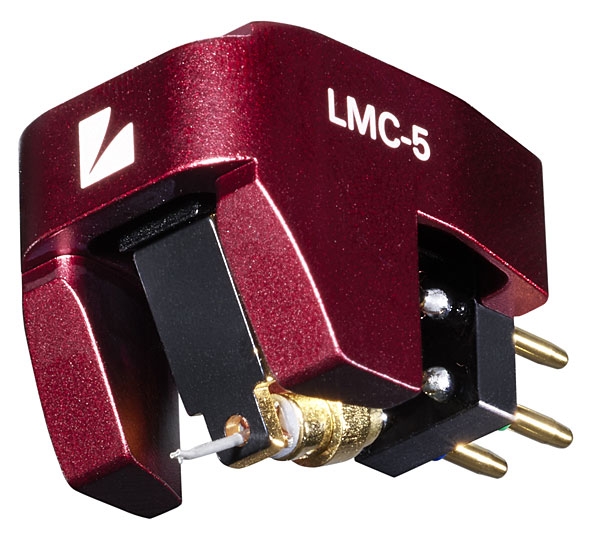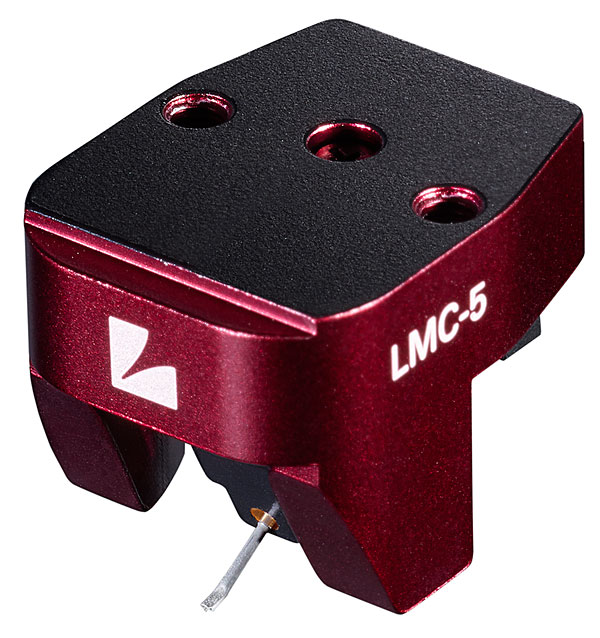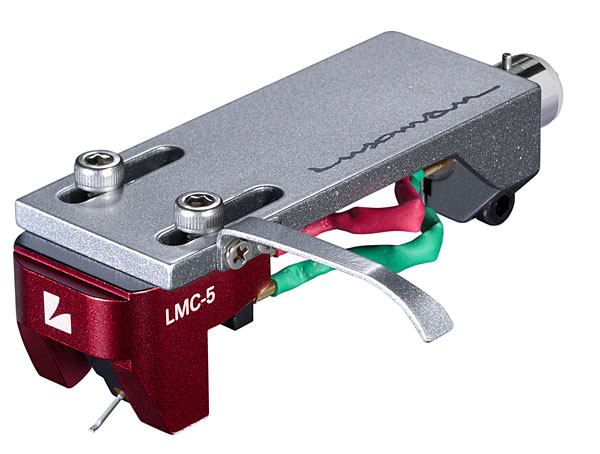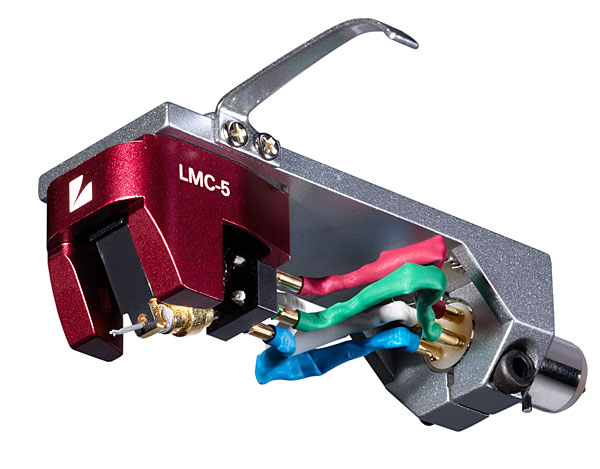| Columns Retired Columns & Blogs |
I wish that stereophile would measure cartridges, similar to HiFiNews. Along with these measurements, any comments about how to best interpret would be appreciated as well.

Anodized in snazzy Luxman red, branded with a laser-etched, '70s-looking, flower-powered "L," and backed by almost 100 years of high-fidelity expertise, the aluminum-body LMC-5 is worthy of close inspection.
40 is a nice, round number, but that's mostly a coincidence. "LMC-5 development began several years ago with its launch timeframe planned to coincide with the introduction of new Luxman turntable models," explained John Pravel, Luxman America's VP of sales. But the cartridge was ready first. "The global pandemic situation intervened," delaying the introduction of those turntables until later this year.
So, obvious question: What happened to the LMC-3 and LMC-4? "Number 3 is reserved for a future project," Pravel told me. "Luxman product planners do not favor even numbers, with the number '4' especially unpopular, a cultural/language taboo throughout much of Asia." Hence, LMC-5.

Design
At the business end of the LMC-5, Luxman employs a Shibata stylus, which is affixed to a low-mass, 0.5mm-thick aluminum-pipe cantilever with both press fitting and an adhesive bond using epoxy resin. The cart's 4-nines, high-purity copper-coil windings consist of urethane-enameled piano wire 30µm thick.
The LMC-5 motor incorporates a "cross-mounted iron core with the left and right coils wound symmetrically for superior channel separation," a press release stated; the specified channel separation is 28dB. "Because the coil and [samarium/cobalt] magnetic field are uncommonly compact, the cartridge is highly resistant to external noise."
Luxman suggests a vertical tracking angle of 25°, which the company says yields a stylus rake angle of 0° (or 90°). The recommended tracking force is 2.2gm, the output voltage is 0.4mV, and the reported frequency range is 10Hz–35kHz. The recommended load impedance is 40 ohms—2.5 to 10 ohms if you're using a step-up transformer. Dynamic compliance is 8 × 10–6cm/dyne at 100Hz, which is moderately low; the LMC-5 weighs a modest 8.6gm, so a tonearm of reasonably high mass will make the best match.
The LMC-5 was designed by a two-man team—engineers Mr. Hagiwara and Mr. Nagatsuma—with a very specific goal. "The "great difficulty that many phono cartridges have [is] correctly reproducing the full scale, dynamics, and harmonic overtones of a concert grand piano," Mr. Hagiwara said, quoted in a PR document prepared by Pravel. That challenge drove the Luxman LMC-5 development team toward realizing its goal, the document concludes.
The LMC-5's body underwent several iterations of shape and material before the final design was settled on. Luxman chose an open-body design for the LMC-5 because "the coil and cantilever assembly of [closed-body designs] can behave like a microphone, picking up reflected sound from the vinyl record surface. With less enclosure, [there is] less potential for sound coloration," Pravel added. An aluminum alloy pipe was chosen as the cantilever material, Pravel said, because more exotic materials—ruby, sapphire, boron, beryllium—yield an "accentuated, hi-fi sound.
Luxman favored the sincere, neutral sound quality of aluminum." For listening tests, Luxman mounted LMC-5 prototypes onto an SME tonearm, situated on a Luxman PD-171AL turntable (armless version, with custom SME tonearm-mounting base). The rest of the assessment system was Luxman's E-250 phono stage, C-900u or CL-1000 preamps, and M-900u, MQ-88u, and MQ-300 power amps. Reference speakers were Focal, among others.

LMC-5 cartridges are assembled by a five-person team employed by an unspecified but well-known Japanese cartridge manufacturer.
Setup
The LMC-5 arrived in a small cardboard box enclosed in a flexible plastic sleeve. Within the package, a smaller leather box held owner's manual, cartridge, stylus protector, six stainless steel screws, two nylon washers, and an Allen key.
Using the body's convenient threaded holes, I mounted the LMC-5 to the headshell of a Kuzma 4Point tonearm, attached to my Kuzma Stabi R turntable. I used a Feickert Next Generation Universal Protractor to align the cartridge and a Riverstone Audio electronic scale to set the tracking force to the recommended 2.2gm. The cartridge's output was boosted by a Sculpture A Mini Nano SUT, which output its higher voltage into the MM inputs of a Tavish Audio Design Adagio phono stage. A 2m RCA pair of Analysis Plus Silver Apex cables connected the phono stage to the inputs of a Sugden LA-4 preamplifier, then on to a Pass Labs XA-25 power amplifier via a pair of Triode Wire Labs Spirit II (RCA) cables.
A 10' pair of Analysis Plus Silver Apex cables connected the Pass Labs amplifier to my reference DeVore Fidelity Orangutan O/96 loudspeakers.
Listening
I was impressed with the rich tone and pure, detailed, hugely illustrative sound of the LMC-5, right out of the box. Break-in made it better. Lovely clarity and openness in the upper midrange and treble resulted in textural shading, touch, and illumination of inner detail. Snare drums, cymbals, guitars, wind instruments, and female voices were bathed in a generous glow, paced by a sense of resolution and ease. The cart, though, had abundant transient snap when it was needed. Nothing about the LMC-5 was etched, strained, or ear-biting; I heard only richly toned, organic, well-textured sound. The LMC-5 sounded whole, weaving together ambient cues with instrumental textures and tones into a well-sorted, well-scaled soundstage.

The LMC-5's recreation of acoustic bass, massed strings, and bass-region drums was smooth and strong. The tonality and projection of Philly Joe Jones's toms on Art Pepper's Meets the Rhythm Section (Original Jazz Classics OJC-338) was immaculate, the best I've heard. Yet, the LMC-5 was more about sweetness than slam. Bass notes were warm and nicely sized but lacked the last degree of grip, punch, and extension. Top-to-bottom coherence was the LMC-5's most salient characteristic, alongside a refined treble and sweetly transparent midrange. Tonal purity, speed, refinement, and resolution were the LMC-5's take-home message.
Microdynamics and microdetail were also top notch through the LMC-5. The cart highlighted surface noise on some LPs but also revealed such minutiae as the crisp, airy vibrations of wire snares on the bottom head of a snare drum, tiny changes in air pressure that made well-recorded vocalists seem real, and subtle inflections of air pressure within saxophones, which helped carve John Coltrane's and Art Pepper's saxophones out of space.
On "You'd Be So Nice to Come Home To," the quartet of Pepper (alto saxophone), Red Garland (piano), Paul Chambers (acoustic bass), and drummer Jones blasted out a big soundstage with near-3D, physical images driving the music. The sound was open, clean, snappy ... it sent me! The midrange to treble of Pepper's alto horn and brushes on snare drum were alive. The soundstage was deep, populated by fleshy, human images that had transient snap, force, and energy. The LMC-5 enabled a nearly live performance in my small listening warren, the cart defying room size to recreate spatial splendor and physical immediacy.
The LMC-5 delivered a feast of textures on the second movement of Joseph Haydn's Op.74 No.1 in C Major, performed by the Auryn Quartet and recorded using a pair of Neumann CM3 microphones (Das Mikrofon, Tacet L17). The quartet's string tone was penetrating, forceful, deliberate. The sound was not overly lush or soft but rather truthful and resolved, explicit, and 3D-realistic. The LMC-5's ability to extract detail in a musical, nonanalytical fashion consistently impressed.
The Luxman performed similar feats with Floating Points' electronic reverie, Crush (Ninja Tune ZEN259); the intricate synth tones, odd gurgles, and bubbling rhythms sound like angry frogs mating, all tough, stinging textures and edgy beats.

The LMC-5 is a detail and texture king. It never punctured the ears or the senses. It straddled a perfect divide between rich tone and silken textures within a big, deep soundstage. The LMC-5 was never forward, but it was direct.
Playing the same records on my Thorens TD 124 Mk.II turntable with Jelco TS-350S MKll tonearm and Ortofon SPU Classic G MkII cart was an entirely different experience. The soundstage was bigger, the attack was softer, and instruments were less well defined. The sound was pleasing, but it lacked the purity and resolution of the Kuzma/Luxman combo.
Exchanging the LMC-5 for my EMT TSD 15 on the Kuzma produced a different sound, but it was less profoundly different. The EMT on the Kuzma sounded less supple, but it added bass heft, touch, and grip. The EMT was less rich but had a more compact, forceful sound and was slightly forward by comparison. Textures were more visceral and knotty than silken. The LMC-5 brought the honey, the EMT the salt.
Conclusion
$2695 is a sweet spot in moving coil cartridge prices. You've left the sub-$1000 garage and are headed toward Valhalla-like terrain where reality and color begin to surpass imagination.
On Stereophile's Recommended Components list, there's a hole at this level. The EMT TSD 15 slides in at $1950. The Ortofon SPU Wood A ($2519) and Ortofon Cadenza Black ($2879) are priced slightly higher; the DS Audio DS-E1 optical cartridge costs $2750 with its essential equalizer. The Luxman LMC-5 moving coil phono cartridge strides into this company like Wyatt Earp hitting Tombstone, ready to rumble. It made my records sing. The LMC-5 is a superb product from a historic audio company that continues to push the sonic envelope into the future.

I wish that stereophile would measure cartridges, similar to HiFiNews. Along with these measurements, any comments about how to best interpret would be appreciated as well.

I wish cartridge manufacturers would be upfront about the lifespan of their styluses and mention it in their specs. Some charge stratospheric prices, but aside from Van den Hul who guarantees his cartridges to 3000 hours, for his VDH type 1 or VDH type 2, I know of no other manufacturer who publishes this information. The best we get when push comes to shove is that by 1000 hours the cartridge should be checked. Others like JICO state 500 hours the stylus is done. Surely Linn's latest Ekstatik cartridge at $7,150 can't only be good for 1000 hours. Can it?

LMC-5 cartridges are assembled by a five-person team employed by an unspecified but well-known Japanese cartridge manufacturer.
Could well be Audio-Technica, given that Luxman's 320C high-output MC cartridge was a rebadged AT3100XE...